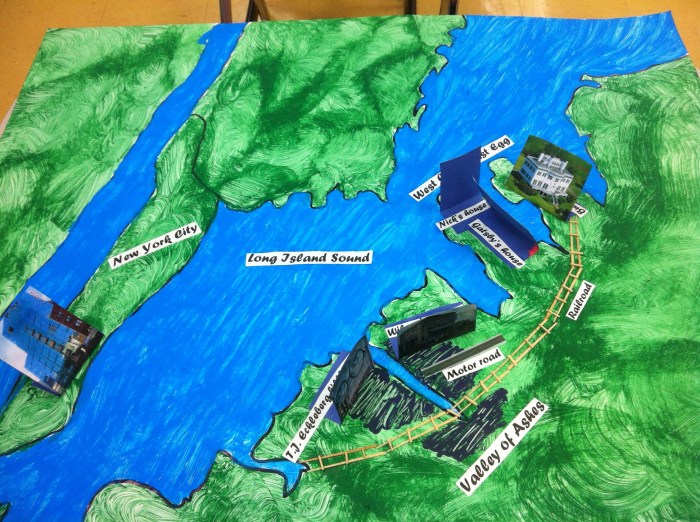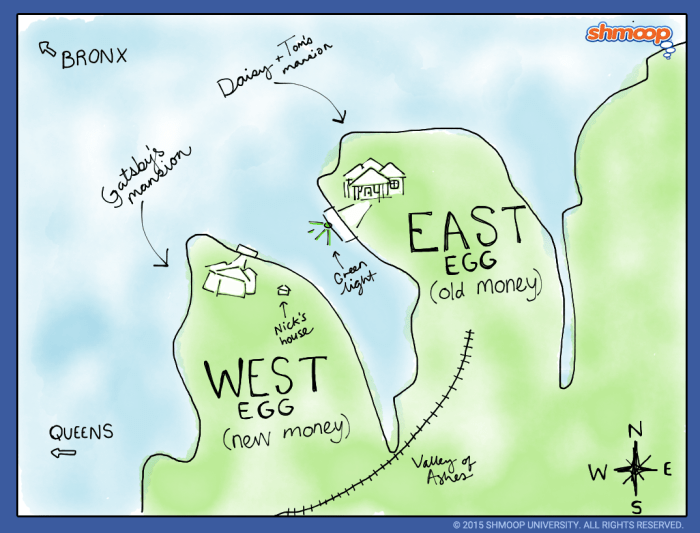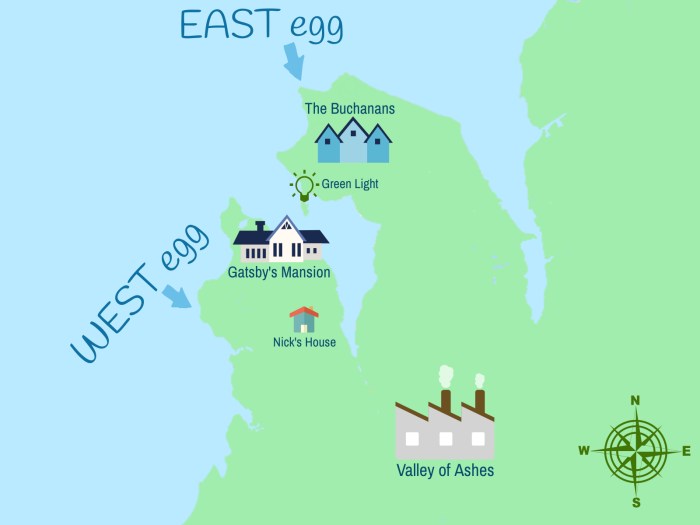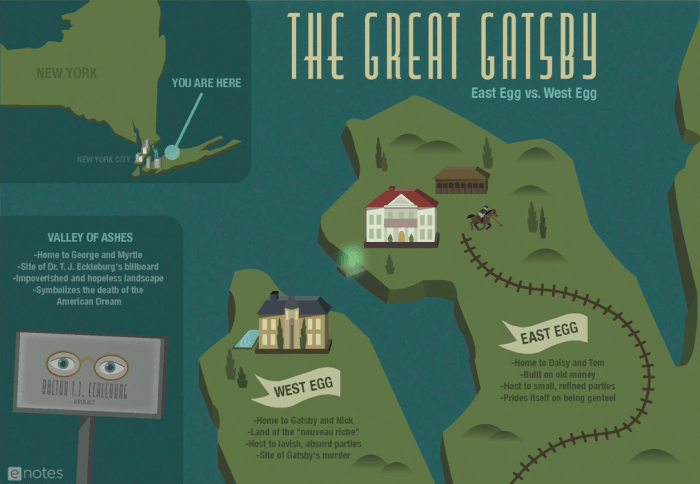The map of the Great Gatsby is not merely a geographical guide to the novel’s setting; it is a profound literary device that unravels the intricate tapestry of characters, themes, and symbols. As we delve into this iconic map, we embark on a journey through the roaring twenties, where social divides, wealth disparities, and the elusive American Dream collide.
Fitzgerald’s meticulous crafting of the map reveals the stark contrasts between the opulent East Egg and the industrial Valley of Ashes, mirroring the social and economic chasms that shape the characters’ lives.
Historical Context

The Roaring Twenties, a period of economic prosperity and social change in the United States, provides the backdrop for F. Scott Fitzgerald’s “The Great Gatsby.” This era witnessed a surge in consumerism, a relaxation of social norms, and a rise in jazz music and flapper culture.
The novel captures the essence of this transformative time, exploring the pursuit of wealth, the search for meaning, and the allure of the American Dream.
Social and Cultural Factors
The Roaring Twenties witnessed a significant shift in social and cultural values. The end of World War I brought a sense of liberation and a desire to break free from traditional constraints.
- Consumerism:Economic prosperity fueled a surge in consumerism, with people eager to acquire material possessions and experience new forms of entertainment.
- Relaxation of Social Norms:The era saw a loosening of social conventions, particularly among the younger generation. Flappers, with their short skirts and bobbed hair, challenged traditional gender roles.
- Jazz Music and Flapper Culture:Jazz music became immensely popular, and flappers emerged as a symbol of the carefree and hedonistic spirit of the time.
Geographic Setting

The map of West Egg and East Egg portrays a distinct geographical divide that mirrors the social stratification within the novel. West Egg, situated across the bay from New York City, is characterized by its ostentatious mansions and flashy wealth, while East Egg, on the other side of the peninsula, exudes an air of established aristocracy and understated elegance.
Physical Separation and Social Divide
The physical separation between the two eggs underscores the social chasm that exists between the nouveau riche of West Egg and the old money families of East Egg. West Egg, with its garish display of wealth and its inhabitants’ desire to be accepted into the upper echelons of society, represents the striving and aspirational nature of the American Dream.
In contrast, East Egg, with its long-standing traditions and its residents’ sense of entitlement, embodies the established order and the exclusivity of the upper class.
Character Relationships

The map of West Egg and East Egg in The Great Gatsbyserves as a microcosm of the social landscape of the novel. It reveals the complex relationships and power dynamics among the major characters.
The following table organizes the major characters based on their connections to the map:
| Character | Location | Connections |
|---|---|---|
| Jay Gatsby | West Egg | Owns a large mansion and throws lavish parties to attract Daisy Buchanan’s attention |
| Daisy Buchanan | East Egg | Married to Tom Buchanan, but has an affair with Gatsby |
| Tom Buchanan | East Egg | Wealthy and arrogant husband of Daisy, who is suspicious of Gatsby’s intentions |
| Jordan Baker | East Egg | Professional golfer and friend of Daisy Buchanan, who introduces Nick Carraway to Gatsby |
| Nick Carraway | West Egg | Narrator of the novel and Gatsby’s neighbor, who becomes involved in the relationships between the other characters |
The map reveals the physical and social distance between the characters. Gatsby lives in the newly developed West Egg, which is associated with wealth and excess. East Egg, on the other hand, is home to the established elite, including the Buchanans and Jordan Baker.
The fact that Gatsby lives across the bay from Daisy symbolizes the social barriers that separate them.
The map also highlights the power dynamics among the characters. Gatsby is a self-made millionaire who has amassed his wealth through questionable means. Tom Buchanan, on the other hand, is a member of the old money aristocracy. Gatsby’s wealth and ambition threaten Tom’s social status, which leads to a rivalry between the two men.
If you’re exploring the fictional world of The Great Gatsby, you might find yourself wondering about the map that depicts the characters’ glamorous lives. This map is not just a fictional creation; it’s based on the real-life Gold Coast of Long Island, a playground for the wealthy in the 1920s.
And guess who was one of the prominent figures of that era? Elder John C. Pingree Jr., a successful businessman and philanthropist. Read more about his fascinating life and his connection to the map of The Great Gatsby.
Symbolism and Themes
The Great Gatsby is a novel rich in symbolism, with many locations on the map representing different themes and ideas.
Valley of Ashes
The Valley of Ashes is a desolate industrial area between West Egg and New York City. It symbolizes the moral and economic decay that underlies the American Dream. The valley is filled with factories, ash heaps, and poverty-stricken workers. It is a harsh and unforgiving place that represents the dark side of the American Dream.
Gatsby’s Mansion
Gatsby’s mansion is a symbol of his wealth and ambition. It is a huge, opulent palace that is filled with expensive furniture and art. Gatsby’s mansion is a testament to his desire to achieve the American Dream, but it is also a reminder of the emptiness of that dream.
Gatsby’s mansion is ultimately a symbol of the failure of the American Dream.
These symbols contribute to the novel’s themes of wealth, class, and the American Dream. The Valley of Ashes represents the dark side of the American Dream, while Gatsby’s mansion represents the emptiness of that dream. The novel shows that the American Dream is not always what it seems, and that it can often lead to disappointment and disillusionment.
Literary Techniques

Fitzgerald masterfully employs the map as a literary device to foreshadow events and build suspense throughout the novel.
The map serves as a visual representation of the characters’ relationships and the complex web of connections between them. The physical distance between West Egg and East Egg, as well as the different routes that connect the two, mirror the emotional and social barriers that separate the characters.
Foreshadowing and Suspense
- The map foreshadows the tragic events that unfold throughout the novel. The bay between West Egg and East Egg, which is represented as a vast expanse of water on the map, symbolizes the insurmountable divide between Gatsby and Daisy.
- The map also creates suspense by highlighting the proximity of the characters to one another. The close proximity of Gatsby’s mansion to Daisy’s house, as well as the ease of access between the two, foreshadows the inevitable collision between the two characters.
Setting and Atmosphere, Map of the great gatsby
The map establishes the novel’s setting and atmosphere by providing a detailed depiction of the geographical layout of Long Island. The map’s focus on the North Shore, with its exclusive mansions and sprawling estates, creates a sense of wealth and privilege that permeates the novel.
The map also contributes to the novel’s atmosphere of longing and nostalgia. The faded and torn condition of the map, as well as its handwritten annotations, evokes a sense of the past and the passage of time.
Essential FAQs: Map Of The Great Gatsby
What is the significance of the Valley of Ashes in the map of the Great Gatsby?
The Valley of Ashes represents the desolate industrial wasteland that separates East Egg from West Egg, symbolizing the moral and economic decay that lies beneath the glittering facade of the Roaring Twenties.
How does the map reveal the complex relationships between the characters?
The map organizes the characters based on their connections to specific locations, highlighting the power dynamics and social hierarchies that shape their interactions.
